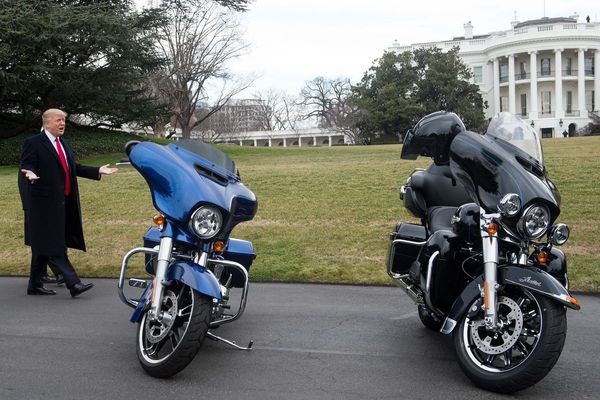
Forget the Tata Aria. That’s something Tata Motors wants you to do, and, if you spend some time with the new Hexa, you would relies that it isn’t too much to ask for. Yes, it sports a similar silhouette and a few carry-over bits, but the sheer depth of improvement that’s gone into this car makes it far greater than a mere facelift of the Aria.
On the other hand, Mahindra too updated the XUV500 in 2015. No name change or drastic engineering overhaul here – just a more conventional facelift; but the raft of little changes, both cosmetic and technical, ironed out so many of the car’s niggles that it finally felt like the car it always should have been.
But which one of these homegrown premium SUVs should you buy?
The posers
If there’s one visual factor that’s been carried over from the Aria to the Hexa, it’s the MPV-like glasshouse. But that said, the Hexa does look a lot more SUV-like. The bonnet is taller and more upright now, it’s got a nice hexagonal pattern to the upper and lower grilles, and there’s grey plastic cladding everywhere! You also get rather fetching 19-inch wheels but they look a bit sunken in the massive wheel wells.

While Tata’s designers added drama to liven up a dull design, Mahindra’s designers actually toned the XUV500’s styling down a notch, and it really works. The headlamps get a new layout and LED accents, the front bumper is new –the gimmicky ‘cheetah whiskers’ have mercifully been given amiss – and there are new modern-looking alloys. Interestingly, although the Hexa has the more traditional SUV ladder-frame construction, it’s the monocoque XUV500 looks more like an SUV.
Luxury quotient
The XUV500’s interior features a nice beige-and-grey theme, the instrument dials glow in a cool shade of blue, and some of the poor plastics around the cabin are better disguised. The result is that it looks a lot more mature than older versions of the XUV500. It’s quite a practical cabin too, with lots of useful storage bays and cubbyholes, and many will like the larger touchscreen infotainment system on the newer model. However, despite all the changes, it still lacks that richness or feel-good factor that you expect from a car in this segment.

There was only so much Tata could do with the Hexa’s exterior, but on the inside, they’ve really gone to town. The brand new dashboard design is like nothing ever seen on a Tata, and fit and finish has taken a quantum leap forward. As a result, this cabin does a much better job of imparting a premium feel than the Mahindra. However, get to a toll booth and you’ll notice one big flaw in the design; there’s no place to put your change. Yes, the co-driver gets two gloveboxes and a recess above them, but the driver just gets one cupholder. The door pockets are at least big enough to house litre bottles and there is a small bin under the armrest, but a few more cubbyholes wouldn’t have gone amiss.
Vanity vans
It’s a bit of a climb into the Hexa’s cabin, you’re sat very high up and the steering wheel is angled a bit more forward than in a regular car. General visibility is very good, but there’s also a slight blind spot around the A-pillar, and you’ll notice there’s no room for your clutch foot, thanks to the seriously wide transmission tunnel.
The XUV500 is a bit friendlier that way, with a lower, more car-like driving position, and, though forward visibility is good, the view out the back is poor thanks to the tiny rear window. The ergonomics feel a bit more natural, the seats are really good too, and offer a host of electrical adjustment for the driver. The Hexa’s seats aren’t powered, but they are superior in every other respect. Not only do they offer better support overall, their cushions too feel plusher.
This continues in the second row, where, again, the XUV’s seats are in no way bad, but the Hexa’s are just better. Middle-row passengers in the Tata have the advantage of pull-up sun blinds, and they’ll also like the additional set of AC vents that sit between the front seats. The XUV appears to have a bit more space in the second row, but that’s because it is placed quite a bit higher than the first row. So, not only do you get a bit more room to stretch out, you also get a better view forward.

Both SUVs’ middle rows split, recline, fold and tumble for convenience, but when it comes to accessing the third row, the XUV500’s lower stance make it the easier one to get into. However, once you’ve, clambered into the back of the Hexa, you’ll realise that it’s clearly got the plusher seats. Also, the shape of the seating area and the softer cushions make the Tata’s third row the nicer place to be in.
In the luggage department, it’s really no contest. The XUV500 with all its rows up has almost no boot space to speak of, whereas in the Hexa, you can easily fit a medium-size suitcase. And how does the Mahindra claw back an advantage? Equipment. Sure, the Tata has got goodies like a 10-speaker JBL sound system and a USB charging point for the second row, but its touchscreen is small and not very responsive. The XUV’s larger updated touchscreen is slick and packs in loads of features, including a detailed fuel computer and tyre-pressure monitoring. Its equipment list also includes keyless entry and go, navigation, telescopic steering adjustment, a mild-hybrid system and, most of all, a sunroof.
Running gear
Just as with the way they look, these two couldn’t be more different to drive, and that’s because they’re so differently constructed. Where the Hexa uses an industrious ladder-frame body and a rear-biased 4x4 system, the Mahindra gets a significantly lighter monocoque chassis with a front-biased AWD. What they have in common here, on paper at least, is the use of 2.2-litre diesel engines and six-speed manual gearboxes.
Tata’s latest ‘Varicor 400’ motor punches out a meaty 156hp and 400Nm, which is a fair bit more than Mahindra’s 140hp and 330Nm, so of course, the Hexa is quicker, right? Wrong. Owing mostly to its immense, near-2.3-tonne weight (almost 500kg more than the XUV), the Tata is almost 2sec slower to 100kph than the Mahindra. However, despite all that weight, the Hexa’s motor offers oceans of pulling power, which helps in overtaking. Neither SUV is very refined, but the Tata comes out on top, not just on engine noise, but overall insulation as well.

Both cars make for great highway cruisers with their solid road manners (the Hexa feels better planted at high speeds). But in town-traffic, you can feel every one of the Hexa’s kilogrammes thanks to its heavy hydraulic steering that makes U-turns a lot of work. Then there’s the heavy gearshift, which doesn’t slot in easily, and that’s after you’ve gotten past the heavy clutch. The Mahindra isn’t perfect either, with a slightly clunky gearshift of its own, but at least the shift action is light. Also light is the electric power steering, which makes it so much easier to manoeuvre in traffic.
On slightly tougher mountain roads, however, it’s the heavier Hexa that feels a lot more confidence-inspiring to drive than the lighter, lower XUV500. The Hexa’s tyres offer a lot of grip, and, it’s also got a more solid-feeling steering.
Where the Hexa really hits a home run, however, is ride quality. It manages to pummel out all manner of road imperfections at all speeds. The Mahindra can get a bit choppy at times, and it will crash over sharp bumps that the Tata will just sail over.
Hero Hunting
It’s a really close battle that we have here. What’s clear is that the Hexa really takes the Tata brand into new, properly premium territory. That’s something Mahindra did too when it launched the XUV500, and that original formula has since been refined with great effect. That said, the XUV500 doesn’t feel as well-built, and, in terms of comfort, it’s not quite as good as the Tata. Still, it does manage to outshine it in some crucial areas, like ease of driving, fuel efficiency and equipment.

What lets the Hexa down is its weight, heavy steering, clutch and gearbox which make it cumbersome to drive in town. But where Tata has gotten things just right is on the all-important feel-good factor. What’s more, at Rs 17.49 lakh (ex-showroom, Delhi), the Hexa XT 4x4’s price just slips under the XUV500 W10 AWD’s by Rs 11,000, though it’s important to remember these prices are only introductory. The Hexa is more refined and superbly built, it scores high on space and comfort, and its tough underpinnings give it a go-anywhere ability. In a hotly contested segment where image, presence and premium feel play a very important role, these are the things that matter more, and that’s why the Hexa wins this shootout.







